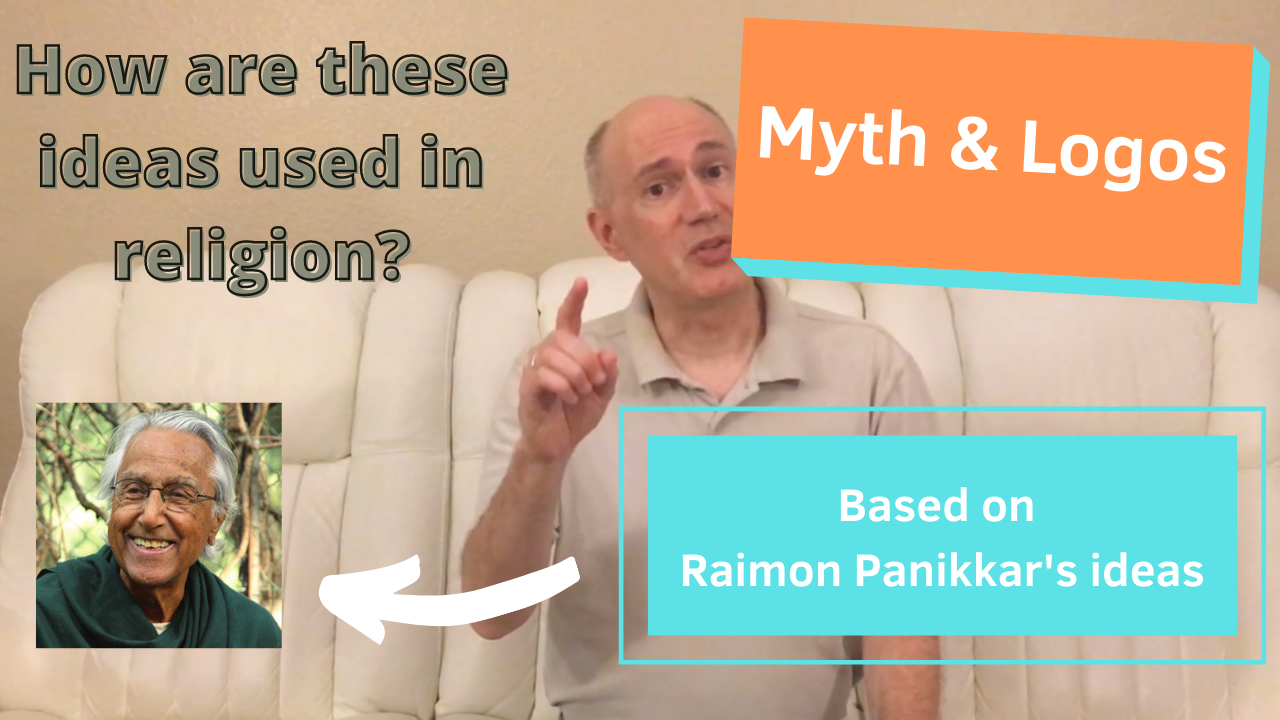04/21/2021 – Myth & Logos in Religion

Oh that’s not true, it’s just a myth. Are you sure? Let me explain. This is TenOnReligion.
Hey peeps, it’s Dr. B. with TenOnReligion. This video is closed-captioned here on YouTube and the transcript is available at TenOnReligion.com. The common usage of the word myth today, as something that is not true or needs to be debunked, is the not the same as the way the term is used in the academic field of religion. The Greek concepts of mythos and logos have a long history back to ancient Greece. The philosopher Plato used myths to make philosophy more accessible. They were based on narratives that were non-falsifiable because they depicted things like beings, places, or events that were beyond human experience. Myths were used as a teaching tool to persuade people to better understand more abstract concepts. Human reason has limits, and when those limits are reached, it has to rely on something beyond itself, or myths.
I already have a video on one thinker who explains this, Raimon Panikkar. In that video I talk about his concept of intrareligious dialogue, but in this one I want to talk about how he describes the relationship between mythos and logos. These two concepts work in concert together. Myth cannot be explained in the same way as logos, it can only be uncovered or revealed. Myth is the subjective frame which houses the objective logos. Myth is what one takes for granted and is something that one is unaware of, some sort of unseen aspect of one’s existence. In religion, when myths transform into something entirely rational, they lose their mythic quality and become demythicized, or reduced to simple moral statements. The interesting thing about this is that myths often just don’t go away. They get replaced. Without realizing it, in the process of myth deconstruction, people birth other myths out of the former myth’s ashes. Old myths transform into new myths, which then become transparent with the old myth often remaining unrecognizable within. When the old myth is explained, it is explained away, in the same way that innocence, once lost, cannot be regained. The myth then searches for a new innocence.
So where does logos fit into all of this? The logos has meaning and can function only within its respective myth. Think of the concept of tolerance for a minute. Beyond certain limits, tolerance is not possible. On the level of logos one can tolerate anything as long as it fits into one’s thought systems. When incompatibility arises, myth must then be discovered as another mode of communication. Tolerance is a myth based upon a balance of power in yet another, deeper shared myth. Something lying underneath unites both parties. The logos puts into words, as much as is possible, the underlying myth.
There is where symbols come into the picture. Religious symbols are the external manifestation of myths. Religious symbols represent a relationship. This relational character, however, does not mean it devolves into a total relativism, which is marked by a lack of any criteria for discernment. Rather, relativity is the best way to describe the relationship between religion and symbol. The relationship which religion as symbol possesses is a particular relationship with a particular myth. Each particular religious tradition can understand the term religion in slightly different ways because religion as symbol possesses the feature of multivalence, more than one connecting point, rather than univocality, or a single representational meaning. This might sound kind of strange, but it is best described as a linking of reality from within itself. Here’s an example:
Two of the deities from the Hindu scripture the Rig Veda, Varuna and Indra, also play an important role as symbols of the divine. Varuna is lord over life and death, yet it is ultimately the law of karma which prevails in the universe. All creatures are subject to death and it is karma which determines their future, basically there’s an end point, and then what? In this common destiny of life, that which is normally unseen becomes visible via the living symbol of Varuna. In a similar way, Indra, the warrior god, is also a symbol. Indra, as one who can play a role for good or evil, is a powerful force determined to vanquish all foes. These two gods in their symbolism stand for two poles of the divine. Varuna represents justice and morality while Indra is strength. These struggles take place within the human person. On the one hand, the tension is between justice, morality and the cosmic order. On the other hand, the main thrust is the ability to show victorious force no matter what the conditions. The two symbols of Indra and Varuna as the divine are two myths from the Hindu tradition which demonstrate the symbolic difference, the linking of reality from within itself. They are entirely coherent within the context of the Vedas, the Hindu scriptures, and the larger cultural environment of India and Hinduism, but outside of their own myth, they may not make much sense.
This gives rise to a key question: can religious symbols have any currency outside of their respective myths? Think about theistic traditions, for example, where a personal God is a symbol. Humans can believe in God but not know what God is, as in what kind of “thing” God is, like we do about other objects. Even the term "God" itself can refer to multiple religious referents as in the tetragrammaton, the Trinity, or Allah. When God is made into an object which one can know, God is nothing more than an idol. The personal God of belief is not a concept in the philosophical sense but a symbol because we believe only what we “believe” to be the unquestionable. This again illustrates the difference between mythos and logos. A symbol is in the domain of this in-between space, expressing belief and passing from within a myth to logos. God is real in the sense that the reality of the appearance is already in, and inherently part of, the symbol.
One does not simply see a part of another tradition’s symbol through their religious symbol such that all the religious symbols could be brought together to gain the complete image. The common illustration of the blind men and the elephant does not apply. A religious symbol cannot be just one among many else one would cease to be a genuine adherent of any tradition. What would be the point? A tradition’s symbol is the totality. Adherents of other traditions see it differently and may provide a different interpretation from their vantage point. But the trick is, other traditions initially have to be discovered in one’s own religion while simultaneously not do any violence to them, either conceptually or physically. Not an easy thing for most religious people. When one realizes that the reality of their religious symbols can never be fully exhausted, however, they then can become aware that there is space for more than one religious tradition to engage it. Religious faith is a “both/and” in that a religious believer is both in this world and believing in a beyond, some form of transcendence. Mythos and logos in concert together provide the reality of the symbolic difference. If one experiences a certain feeling of spiritual disequilibrium when one has a positive encounter with a religious symbol outside of one’s own tradition, this is due to the character of relativity inherent in all religious symbols. There is always more space for others. The new innocence can emerge by a changing of the old myth resulting in a new reinterpretation of the symbol. And so the cycle continues. This is why I mentioned earlier that religious symbols are multivalent – they can have more than one connection to transcendence. And there you have it!
Next time we’re going to attempt to sort through some Buddhist ideas. It’ll be fun, hehe. That’s it for today. I hope this vlog has helped you better understand this topic. Until next time, stay curious. If you enjoyed this, please like this video and subscribe to the channel. This is TenOnReligion.
Sources:
https://plato.stanford.edu/entries/plato-myths/
Banas, Mark. 2014. “Myth and Interreligious Understanding in Raimon Panikkar.” Studies in Interreligious Dialogue 24 (2014): 171-181.
Banas, Mark. 2009. “Raimon Panikkar’s Symbolic Difference and Religious Faith,” Interreligious Insight 7:1 (January 2009): 40-47.
Panikkar, R. 1983. “Interview,” Epiphany 3, no. 4 (Summer 1983): 29.
Panikkar, R. 1979. Myth, Faith and Hermeneutics. New York: Paulist Press.
Panikkar, R. 1989. “The Ongoing Dialogue,” Hindu-Christian Studies Bulletin 2 (1989): 10.
Panikkar, R. 1998. “Religion, Philosophy and Culture.” Interculture (Montréal) 31, no. 4, issue no. 135 (Summer-Fall 1998): 99-120.


